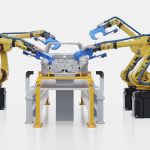A new collaborative project has helped over 100 suppliers in Rolls-Royce’s aerospace network advance their digital maturity—proving that tech adoption only delivers results when people are part of the plan.
Why Digital Maturity Still Hinges on the Human Element
For all the talk of AI, automation, and advanced analytics, the real blockers to digital transformation are rarely technical. In Rolls-Royce’s latest supply chain modernization project, the most meaningful progress came not from tools or systems—but from how people understood and adapted to change.
A project funded by the Made Smarter Innovation programme and led by Aston University has quietly delivered results that matter. Working with more than 100 suppliers across Rolls-Royce’s Connected Tempest supply chain—a key part of the UK’s next-generation aircraft program—the initiative used a method known as Process-Oriented Holonic (PrOH) Modelling to accelerate digital capability building across the network.
The approach is designed to tackle complex, human-centered barriers to transformation. Rather than pushing a uniform tech stack across suppliers, the PrOH methodology enables each organization to identify the cultural, strategic, and operational shifts required to make digital tools actually stick.
Workshops across the network—spanning material providers, advanced component makers, and precision machinery specialists—surfaced the realities many procurement and operations leaders know well: digital strategy often breaks down where frontline processes, leadership alignment, or data confidence aren’t in place.
By focusing on soft systems thinking—an approach that blends systems theory with real-world human behavior—the project helped suppliers map and understand the true root causes of transformation inertia. From that baseline, participants were able to build actionable plans to raise digital maturity in a way that made sense for their unique contexts.
From Pilot to Playbook: What It Means for the Broader Supply Chain
While Rolls-Royce may be the headline name, the impact of this project runs deeper. In bringing together academics, SMEs, engineers, and change leaders, the work created a shared framework that others can now adopt—complete with training tools, templates, and guidance.
Professor Ben Clegg of Aston University, who developed the PrOH approach, describes it as a way to “turn conceptual change management into something usable, measurable, and scalable.” Already trialed in sectors like EV manufacturing and automotive supply, the methodology is now being primed for broader use through short courses and partnerships with industry bodies such as IET and the Operational Research Society.
This is particularly relevant for mid-tier suppliers under pressure to demonstrate digital readiness while maintaining cost efficiency. Rather than dropping in new tech and hoping for the best, leaders now have a model for diagnosing transformation blockers early—and supporting teams in navigating them effectively.
For procurement and operations leaders, the takeaway is clear: digital supply chains aren’t built on tools alone. They require a shared language for change, rooted in both strategy and empathy.
Operational Success in Digital Supply Chains Starts with Alignment
This project should be seen as more than a niche academic effort—it’s a model for how to scale transformation across complex, interdependent networks. And it comes with lessons supply chain leaders can act on right now.
If you’re pushing for digitization in your own supplier base, take a step back from systems implementation and ask: where are the misalignments in process, culture, and capability? Are your partners equipped not just with the right tools, but the mindset and clarity to use them?
The companies that took part in this initiative gained more than digital dashboards. They gained internal alignment, clarity on roles, and a structured way to approach continuous improvement. And in today’s environment—where agility, resilience, and data confidence are top-tier priorities—that’s what turns technology investments into real operational value.







